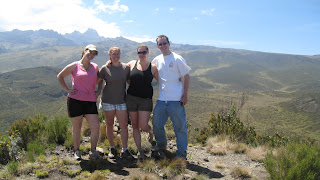Also, if anyone would like to further help the Mjagi family, please feel free to send new/used toddler clothing, girls age 6 clothing, or school supplies to the following address:
Geoffrey Kariuki Mjagi
Mwimbi Boarding School
PO BOX 404
Chogoria, Kenya
Lastly, is the great John, our pleasant 13-year old tour guide from the Mara Falls hike. John offered his time and knowledge of the local terrain to us without asking for anything. A little tip at the end of our adventure, equivalent to a little over 2 dollars, came to him as a sweet surprise. During our walk we talked a lot about his school. He was proud to have just joined the Gitare Primary School, a step up from his public school. He was excited to have access to more books and asked me many times if I had any from America I could give him. So on behalf of Chloe and Jenny Hall especially, I donated all the school supplies I had to his school. I also bought classroom posters and books appropriate for their curriculum from the local paper supply store. The 7 pairs of soccer shoes I brought from Marcilio's Soccer Shoes Project, also went to this school (and a pair already went to John himself). Now, I had to find this school still. My directions were an outstretched arm pointing west from the Mara Falls, "over there, right over that mountain" John said. We grabbed a taxi and gave him the name of the school also, still not much help. Up and down a few ridges outside of Chogoria, we came to the compound after about 30 minutes. They had many acres of flora study plots, a river snaked around the base of the compound. The taxi climbed up the steep driveway, you would have to slide down on your rear if descending by foot.
Gitare Primary School, welcoming students in forefront, latrines behind the school
As soon as the mzungu strolled onto the school yard, faces peered through the open windows and the administrators chatting outside greeted us. They weren't sure who this John was that had advocated for their school, so I had to pull out my camera and show a photo of him..."Oh! the one that lives down by the waterfalls!" And a few moments later, John himself slowly approached us, obviously surprised we actually came. He showed us his new classroom and schoolmates.
8th grade class: the big year for test-taking for high-school entrance
John and the school director, Justus
The school seems to have a link with Alderly Edge School for Girls, in Cheshire England, and projects are planned for remodeling. You can see the project if you search for The Juniper Trust. The administration didn't seem very convinced by the plans, maybe they haven't met them personally or it has been years since the project was initiated. Either way, they have needs now and are trying their best to prepare their pupils for entrance into high school, the first step towards a career other than farming. So if anyone would like to send more school supplies, especially classic novels, you may use the address below!
Justus Murutani
Gitare Primary School
PO Box 338
Chogoria, Kenya 60401
Another quick note, the Hall family had donated several dental instruments. The dental clinic at the hospital, run by Dr. Odonde, was very appreciative and explained that almost everything in the exam room was donated. A warm thank you from their staff.
ASANTE SANA FOR YOUR LOVING DONATIONS!
Stay tuned for the next blog entry on African food...


























